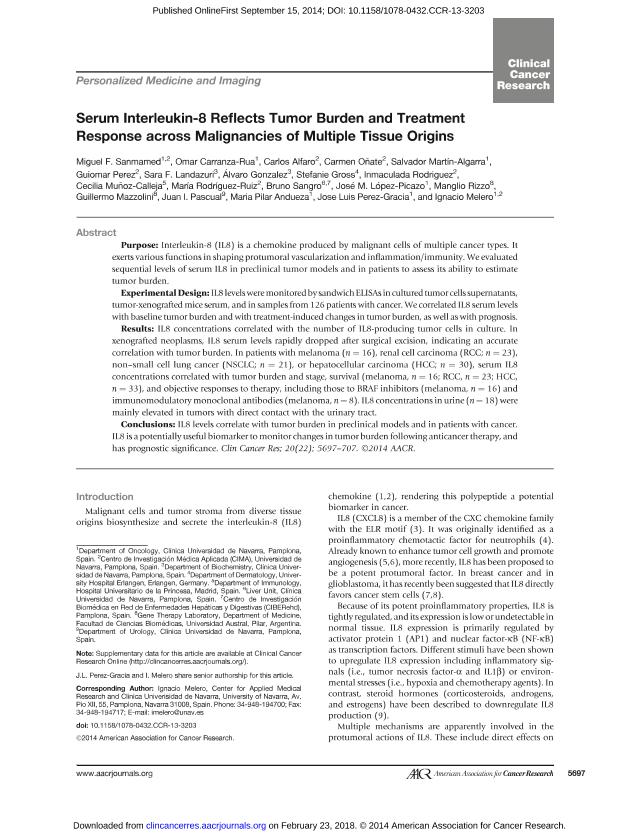Artículo
Serum interleukin-8 reflects tumor burden and treatment response across malignancies of multiple tissue origins
Sanmamed, Miguel F.; Carranza Rua, Omar; Alfaro, Carlos; Oñate, Carmen; Martín Algarra, Salvador; Perez, Guiomar; Landazuri, Sara F.; Gonzalez, Alvaro; Gross, Stefanie; Rodriguez, Inmaculada; Muñoz Calleja, Cecilia; Rodríguez Ruiz, María; Sangro, Bruno; López Picazo, José M.; Rizzo, Manglio Miguel ; Mazzolini Rizzo, Guillermo Daniel
; Mazzolini Rizzo, Guillermo Daniel ; Pascual, Juan I.; Andueza, Maria Pilar; Perez Gracia, Jose Luis; Melero, Ignacio
; Pascual, Juan I.; Andueza, Maria Pilar; Perez Gracia, Jose Luis; Melero, Ignacio
 ; Mazzolini Rizzo, Guillermo Daniel
; Mazzolini Rizzo, Guillermo Daniel ; Pascual, Juan I.; Andueza, Maria Pilar; Perez Gracia, Jose Luis; Melero, Ignacio
; Pascual, Juan I.; Andueza, Maria Pilar; Perez Gracia, Jose Luis; Melero, Ignacio
Fecha de publicación:
11/2014
Editorial:
American Association for Cancer Research
Revista:
Clinical Cancer Research
ISSN:
1078-0432
Idioma:
Inglés
Tipo de recurso:
Artículo publicado
Clasificación temática:
Resumen
Purpose: Interleukin-8 (IL8) is a chemokine produced by malignant cells of multiple cancer types. It exerts various functions in shaping protumoral vascularization and inflammation/immunity. We evaluated sequential levels of serum IL8 in preclinical tumor models and in patients to assess its ability to estimate tumor burden. Experimental Design: IL8 levelsweremonitored by sandwich ELISAs incultured tumor cells supernatants, tumor-xenograftedmice serum, and in samples from126 patients with cancer. Wecorrelated IL8 serumlevels with baseline tumor burden and with treatment-induced changes in tumor burden, as well as with prognosis. Results: IL8 concentrations correlated with the number of IL8-producing tumor cells in culture. In xenografted neoplasms, IL8 serum levels rapidly dropped after surgical excision, indicating an accurate correlation with tumor burden. In patients with melanoma (n = 16), renal cell carcinoma (RCC; n = 23), non-small cell lung cancer (NSCLC; n = 21), or hepatocellular carcinoma (HCC; n = 30), serum IL8 concentrations correlated with tumor burden and stage, survival (melanoma, n = 16; RCC, n = 23; HCC, n = 33), and objective responses to therapy, including those to BRAF inhibitors (melanoma, n = 16) and immunomodulatory monoclonal antibodies (melanoma, n = 8). IL8 concentrations in urine (n = 18) were mainly elevated in tumors with direct contact with the urinary tract. Conclusions: IL8 levels correlate with tumor burden in preclinical models and in patients with cancer. IL8 is a potentially useful biomarker to monitor changes in tumor burden following anticancer therapy, and has prognostic significance.
Palabras clave:
Il-8
,
Cancer
,
Serum Levels
,
Prognosis
Archivos asociados
Licencia
Identificadores
Colecciones
Articulos(SEDE CENTRAL)
Articulos de SEDE CENTRAL
Articulos de SEDE CENTRAL
Citación
Sanmamed, Miguel F.; Carranza Rua, Omar; Alfaro, Carlos; Oñate, Carmen; Martín Algarra, Salvador; et al.; Serum interleukin-8 reflects tumor burden and treatment response across malignancies of multiple tissue origins; American Association for Cancer Research; Clinical Cancer Research; 20; 22; 11-2014; 5697-5707
Compartir
Altmétricas



